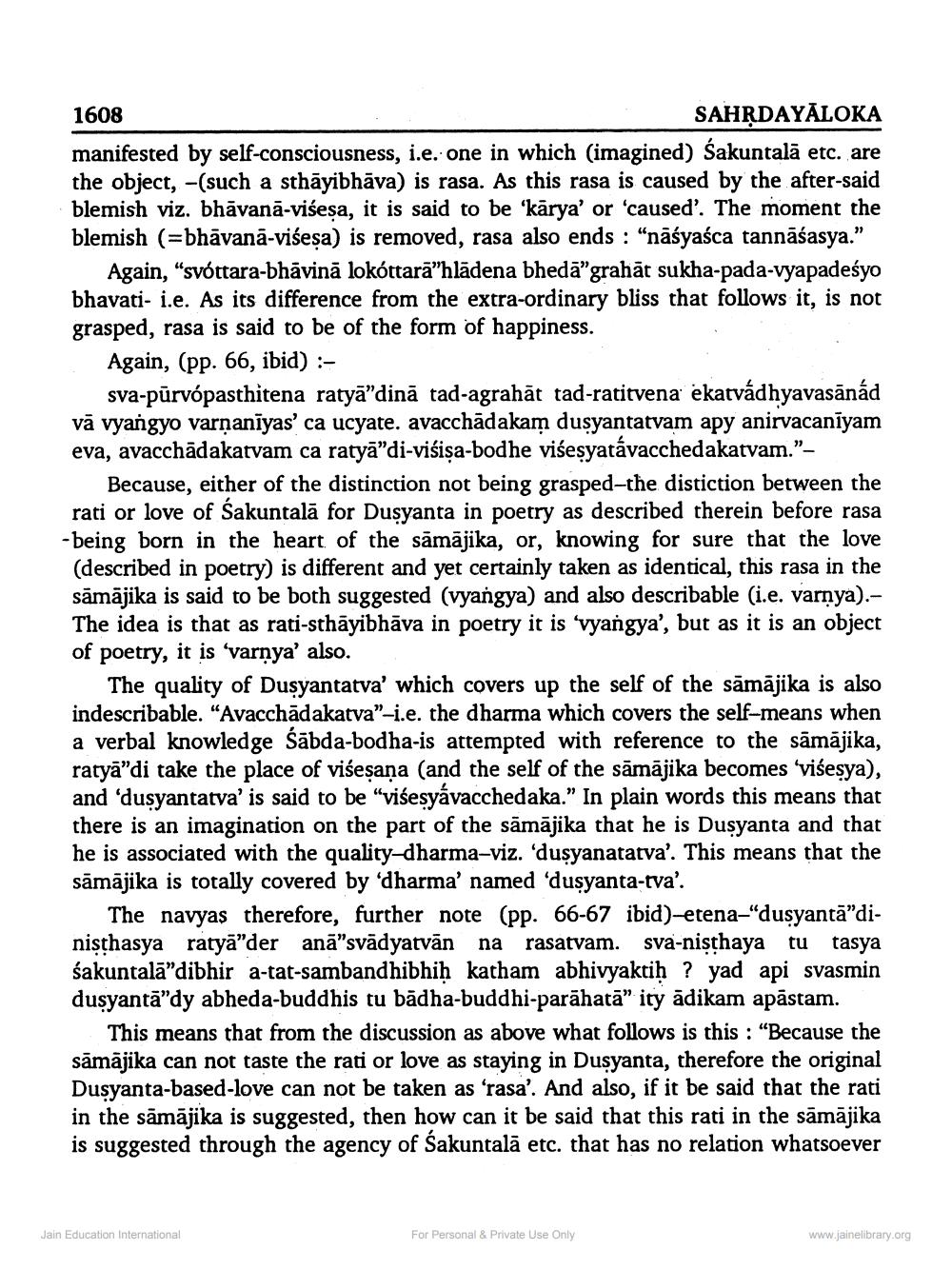________________
1608
SAHṚDAYALOKA
manifested by self-consciousness, i.e. one in which (imagined) Śakuntalā etc. are the object, -(such a sthāyibhāva) is rasa. As this rasa is caused by the after-said blemish viz. bhāvanā-viseṣa, it is said to be 'karya' or 'caused'. The moment the blemish (=bhāvanā-viseṣa) is removed, rasa also ends: "naśyaśca tannāśasya."
Again, "svóttara-bhāvinā lokóttarā"hladena bheda"grahāt sukha-pada-vyapadesyo bhavati- i.e. As its difference from the extra-ordinary bliss that follows it, is not grasped, rasa is said to be of the form of happiness.
Again, (pp. 66, ibid) :
sva-pūrvópasthitena ratyā"dinā tad-agrahat tad-ratitvena ekatvádhyavasanád vā vyangyo varṇaniyas' ca ucyate. avacchādakam dusyantatvam apy anirvacaniyam eva, avacchadakatvam ca ratyā"di-visiṣa-bodhe visesyatávacchedakatvam.”—
Because, either of the distinction not being grasped-the distiction between the rati or love of Śakuntala for Duṣyanta in poetry as described therein before rasa -being born in the heart of the sāmājika, or, knowing for sure that the love (described in poetry) is different and yet certainly taken as identical, this rasa in the sāmājika is said to be both suggested (vyangya) and also describable (i.e. varnya).The idea is that as rati-sthāyibhāva in poetry it is 'vyangya', but as it is an object of poetry, it is 'varnya' also.
The quality of Dusyantatva' which covers up the self of the sāmājika is also indescribable. "Avacchādakatva"-i.e. the dharma which covers the self-means when a verbal knowledge Śabda-bodha-is attempted with reference to the sāmājika, ratyā"di take the place of viseṣana (and the self of the sāmājika becomes 'visesya), and 'duşyantatva' is said to be "viseṣyávacchedaka." In plain words this means that there is an imagination on the part of the sāmājika that he is Dusyanta and that he is associated with the quality-dharma-viz. 'duşyanatatva'. This means that the sāmājika is totally covered by 'dharma' named 'duşyanta-tva'.
The navyas therefore, further note (pp. 66-67 ibid)-etena-"duṣyantā❞diniṣṭhasya ratyā"der anā"svādyatvān na rasatvam. sva-nisthaya tu tasya śakuntala"dibhir a-tat-sambandhibhiḥ katham abhivyaktiḥ ? yad api svasmin dusyanta"dy abheda-buddhis tu badha-buddhi-parāhatā" ity adikam apāstam.
This means that from the discussion as above what follows is this: "Because the sāmājika can not taste the rati or love as staying in Dusyanta, therefore the original Dusyanta-based-love can not be taken as 'rasa'. And also, if it be said that the rati in the sāmājika is suggested, then how can it be said that this rati in the sāmājika is suggested through the agency of Sakuntala etc. that has no relation whatsoever
Jain Education International
For Personal & Private Use Only
www.jainelibrary.org




